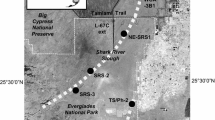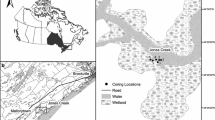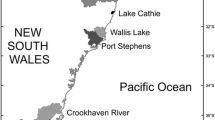Abstract
Successfully rehabilitating drained wetlands through hydrologic restoration is dependent on defining restoration targets, a process that is informed by pre-drainage conditions, as well as understanding linkages between hydrology and ecosystem structure. Paleoecological records can inform restoration goals by revealing long-term patterns of change, but are dependent on preservation of biomarkers that provide meaningful interpretations of environmental change. In the Florida Everglades, paleohydrological hind-casting could improve restoration forecasting, but frequent drying of marsh soils leads to poor preservation of many biomarkers. To determine the effectiveness of employing siliceous subfossils in paleohydrological reconstructions, we examined diatoms, plant and sponge silico-sclerids from three soil cores in the central Everglades marshes. Subfossil quality varied among cores, but the abundance of recognizable specimens was sufficient to infer 1,000–3,000 years of hydrologic change at decadal to centennial resolution. Phytolith morphotypes were linked to key marsh plant species to indirectly measure fluctuations in water depth. A modern dataset was used to derive diatom-based inferences of water depth and hydroperiod (R2 = 0.63, 0.47; RMSE = 14 cm, 120 days, respectively). Changes in subfossil quality and abundances at centennial time-scales were associated with mid-Holocene climate events including the Little Ice Age and Medieval Warm Period, while decadal-scale fluctuations in assemblage structure during the twentieth century suggested co-regulation of hydrology by cyclical climate drivers (particularly the Atlantic Multidecadal Oscillation) and water management changes. The successful reconstructions based on siliceous subfossils shown here at a coarse temporal scale (i.e., decadal to centennial) advocate for their application in more highly resolved (i.e., subdecadal) records, which should improve the ability of water managers to target the quantity and variability of water flows appropriate for hydrologic restoration.







Similar content being viewed by others
References
Anderson W, Gaiser EE (2012) Understanding paleoenvironmental change in Everglades wetlands. J Paleolimnol (Submitted)
Barker P, Fontes J-C, Gasse F, Druart J-C (1994) Experimental dissolution of diatom silica in concentrated salt solutions and implications for paleoenvironmental reconstruction. Limnol Oceanogr 39:99–110
Beckage B, Platt WJ, Slocum MG, Panko B (2003) Influence of the El Niño Southern Oscillation on fire regimes in the Florida Everglades. Ecology 84:3124–3130
Bernhardt CE, Willard DA (2009) Response of the Everglades ridge and slough landscape to climate variability and 20th-century water management. Ecol Appl 19:1723–1738
Birks HJB (1995) Quantitative paleoenvironmetal reconstructions. In: Maddy D, Brew JS (eds) Statistical modeling of quaternary science data, vol 5. Quaternary Research Association, Cambridge, pp 161–236
Childers DL, Doren RF, Jones R, Noe GB, Rugge M, Scinto LJ (2003) Decadal change in vegetation and soil phosphorus pattern across the Everglades landscape. J Environ Qual 32:344–362
Childers DL, Iwaniec D, Rondeau D, Rubio G, Verdon E, Madden CJ (2006) Responses of sawgrass and spikerush to variation in hydrologic drivers and salinity in southern Everglades marshes. Hydrobiologia 569:273–292
Chmura GL, Stone PA, Ross MS (2006) Non-pollen subfossils in Everglades sediments. Rev Paleobot Palynol 141:103–119
Cooper SR, Huvane J, Vaithiyanathan P, Richardson CJ (1999) Calibration of diatoms along a nutrient gradient in Florida Everglades Water Conservation Area-2A, USA. J Paleolimnol 22:413–437
Cooper S, Gaiser E, Wachnicka A (2010) Estuarine paleoecological reconstructions using diatoms. In: Smol JP, Stoermer EF (eds) The diatoms: applications in environmental and earth sciences, Cambridge University Press
Donders TH, Wagner F, Dilcher D, Visscher H (2005a) Mid- to late-Holocene El Niño Southern Oscillation dynamics reflected in the subtropical terrestrial realm. Proc Natl Acad Sci 102:10904–10908
Donders TH, Wagnder F, Visscher H (2005b) Quantification strategies for human-induced and natural hydrological changes in wetland vegetation, southern Florida, USA. Quat Res 63:333–342
Duever MJ, Meeder JF, Meeder LC, McCollom JM (1994) The climate of South Florida and its role in shaping the Everglades ecosystem. In: Ogden JC, Davis SM (eds) Everglades: the ecosystem and its restoration. St. Lucy Press, Delray Beach, pp 225–248
Duff K, Zeeb B, Smol J (1997) Chrysophyte cyst biogeographical and ecological distributions: a synthesis. J Biogeogr 24:791–812
Enfield DB, Mestas-Nuñez AM, Trimble PJ (2001) The Atlantic multidecadal oscillation and its relation to rainfall and river flows in the continental U.S. Geophys Res Lett 28:2077–2080
Fennema RJ, Neidrauer CJ, Johnson RA, MacVicar TK, Perkins WA (1994) A computer model to simulate natural Everglades hydrology. In: Davis SM, Ogden JC (eds) Everglades: the ecosystem and its restoration. St. Lucie Press, Delray Beach, pp 249–289
Frost TM (1991) Porifera. In: Thorp JH, Covich AP (eds) Ecology and classification of North American freshwater invertebrates. Academic Press Inc, New York, pp 5–124
Gaiser EE (2009) Periphyton as an indicator of restoration in the Everglades. Ecol Indic 9:S37–S45
Gaiser EE, Taylor BE, Brooks MJ (2001) Establishment of wetlands on the southeastern Atlantic Coastal Plain: paleo-limnological evidence of a mid-Holocene hydrologic thresh-hold from a South Carolina pond. J Paleolimnol 26:373–391
Gaiser EE, Wachnicka A, Ruiz P, Tobias FA, Ross MS (2004a) Diatom indicators of ecosystem change in coastal wetlands. In: Bortone S (ed) Estuarine indicators. CRC Press, Boca Raton, pp 127–144
Gaiser EE, Brooks MJ, Kenney W, Schelske CL, Taylor BE (2004b) Interpreting the hydrologic history of a temporary pond using siliceous subfossils. J Paleolimnol 31:63–76
Gaiser EE, Richards JH, Trexler JC, Jones RD, Childers DL (2006a) Periphyton responses to eutrophication in the Florida Everglades: cross-system patterns of structural and compositional change. Limnol Oceanogr 51:617–630
Gaiser EE, Zafiris A, Ruiz PL, Tobias F, Ross MS (2006b) Tracking rates of ecotone migration due to salt-water encroachment using fossil mollusks in coastal South Florida. Hydrobiologia 569:237–257
Gaiser EE, McCormick PV, Hagerthey SE (2010) Landscape patterns of periphyton in the Florida Everglades. Crit Rev Environ Sci Technol 41(S1):92–120
Gaiser EE, Trexler JC, Wetzel PR (2012) Chapter 17: The florida everglades. In: Batzer D, Baldwin A (eds) Wetland habitats of north America: ecology and conservation concerns. University of California Press, Berkeley, pp 231–252
Gleason PJ, Stone P (1994) Age, origin, and landscape evolution of the Everglades peatland. In: Davis SM, Ogden JC (eds) Everglades: the ecosystem and its restoration. St. Lucie Press, Delray Beach
Gottlieb A, Richards JH, Gaiser EE (2005) The effects of desiccation resistance and rewetting on the community structure of Everglades periphyton. Aquat Bot 82:99–112
Gottlieb AD, Richards JH, Gaiser EE (2006) Comparative study of periphyton community structure in long and short hydroperiod Everglades marshes. Hydrobiologia 569:195–207
Grimm EC (1987) CONISS: a FORTRAN 77 program for stratigraphically constrained cluster analysis by the method of incremental sum of squares. Computers & Geosciences 13:13–35
Hagerthey SE, Bellinger BJ, Wheeler K, Gantar M, Gaiser E (2011) Everglades periphyton: a biogeochemical perspective. Crit Rev Environ Sci Technol 41:309–343
Harvey JW, Schaffranek RW, Noe GB, Larsen LG, Nowacki DJ, O’Connor BL (2009) Hydroecological factors governing surface water flow on a low-gradient floodplain. Water Resour Res 45:W03421. doi:10.1029/2008WR007129
Hasle G, Fryxell G (1970) Diatoms: cleaning and mounting for light and electron microscopy. Trans Am Microsci Soc 89:470–474
Haug GH, Hughen KH, Sigman DM, Peterson LC, Roehl U (2001) Southward migration of the intertropical convergence zone through the Holocene. Science 293:1304–1308
Juggins S (2003) C2 User guide: software for ecological and palaeoecological data analysis and visualization. University of Newcastle, Newcastle upon Tyne, UK
Light SS, Dineen JW (1994) Water control in the Everglades: a historical perspective. In: Davis SM, Ogden JC (eds) Everglades: the ecosystem and its restoration. St. Lucy Press, Delray Beach
Lodge TE (2010) The Everglades handbook: understanding the ecosystem, 3rd edn. CRC Press, Boca Raton
Madella, M, Alexandre A, Ball T (2005) International code for phytolith nomenclature 1.0. ICPN working group. Published on-line at http://www.phytolithsociety.org/international-committee-on-.html
Moses CS, Anderson WT, Saunders CJ, and Sklar FH (in press) Local and regional gradients in precipitation and temperature in response to climate teleconnections in South Florida. J Paleolimnol
Pearlstine L, Higer A, Palaseanu M, Fujisaki I, Mazzotti F (2007) Spatially continuous interpolation of water stage and water depths using the everglades depth estimation network (EDEN). Gainesville, FL, Institute of Food and Agriculture, University of Florida, CIR 1521, 2 apps, pp 1–18
Peterson LC, Haug GH (2006) Variability in the mean latitude of the Atlantic Intertropical Convergence Zone as recorded by riverine input of sediments to the Cariaco Basin (Venezuela). PalaeogeogrPalaeoclimPalaeoecol 234:97–113
Piperno D (2006) Phytoliths. AltaMira Press, Lanham
Price RM, Swart PK, Fourqurean JW (2006) Coastal groundwater discharge—an additional source of phosphorus for the oligotrophic wetlands of the Everglades. Hydrobiologia 569:23–36
RECOVER 2010 (2009) Comprehensive Everglades restoration plan system status report. SFWMD, West Palm Beach
Ross MS, Mitchell-Bruker S, Sah JP, Stothoff S, Ruiz PL, Reed DL, Jayachandran K, Coultas CL (2006) Interaction of hydrology and nutrient limitation in the Ridge and Slough landscape of the southern Everglades. Hydrobiologia 569:37–59
Saunders CJ, Gao M, Lynch J, Jaffe R, Childers DL (2006) Using soil profiles of seeds and molecular markers as proxies for sawgrass and wet prairie slough vegetation in Shark Slough, Everglades National Park. Hydrobiologia 569:475–492
Saunders CJ, Jaffe R, Gao M, Anderson W, Lynch JA, Childers D (2008) Decadal to millennial dynamics of ridge-and-slough wetlands in Shark Slough, Everglades National Park: integrating paleoecological data and simulation modeling. National Park Service, Miami, p 78
Science Coordination Team (2003) The role of flow in the Everglades ridge and slough landscape. South Florida ecosystem restoration working group. Available at: http://sofia.usgs.gov/publications/papers/sct_flows/
Sklar FC, Chimney MJ, Newman S, McCormick P, Gawlik D, Miao S, McVoy C, Said W, Newman J, Coronado C, Crozier G, Korvela M, Rutchey K (2005) The ecological–societal underpinnings of Everglades restoration. Front Ecol Environ 3:161–169
Slate JE, Stevenson RJ (2000) Recent and abrupt environmental change in the Florida Everglades indicated from siliceous subfossils. Wetlands 20:346–356
Slate JE, Stevenson RJ (2007) The diatom flora of phosphorus-enriched and unenriched sites in an Everglades marsh. Diatom Res 22:355–386
Smol JP, Birks HJB, Last WM (2001) Tracking environmental change using lake sediments volume 3: terrestrial, algal, and siliceous indicators. Dordrecht Kluwer Academic Publishers, Boston, pp 371–678
Snyder GH, Davidson JM (1994) Everglades agriculture: past, present, and future. In: Davis SM, Ogden JC (eds) Everglades: the ecosystem and its restoration. St. Lucie Press, Delray Beach, pp 85–115
Struyf E, Conley DJ (2009) Silica: an essential nutrient in wetland biogeochemistry. Front Ecol Environ 7:88–94
Tobias FA, Gaiser EE (2006) Taxonomy and distribution of taxa in the genus Gomphonema from the Florida Everglades, U.S.A. Diatom Res 21:379–405
Volkmer-Ribeiro C, de Machado VS (2009) Freshwater sponges (Porifera, Demospongiae) in a benthic filter feeding community at the Guanacaste Dry Forest, Costa Rica. Iheringia, SérZool, Porto Alegre 99(4):335–344
Wachnicka A, Collins S, Gaiser E (in press) Response of diatom assemblages to ~130 years of environmental change in Florida Bay (U.S.A.). J Paleolimnol
Willard DA, Holmes CW, Weimer LM (2001) The Florida ecosystem: climatic and anthropogenic impacts over the last two millennia. Bull Am Paleontol 361:41–55
Willard DA, Bernhardt CE, Korejwo DA, Meyers SR (2005) Impact of millennial-scale Holocene climate variability on eastern North American terrestrial ecosystems: pollen based climatic reconstruction. Glob Planet Change 47:17–35
Willard DA, Bernhardt CE, Holmes CW, Landacre B, Marot M (2006) Response of Everglades tree islands to environmental change. Ecol Monogr 76:565–583
Winkler MG, Sanford PR, Kaplan SW (2001) Hydrology, vegetation, and climate change in the Southern Everglades during the Holocene. In: Wardlaw BR (ed) Bull Am Paleontol 361: 57–98
Zeeb BA, Smol JP (2001) Chrysophyte scales and cysts. In: Smol JP, Birks HJB, Last WM (eds) Tracking Environmental change using lake sediments. Terrestrial, algal, and siliceous indicators, vol 3. Kluwer, Dordrecht, 180 pp
Acknowledgments
This work was supported by a Research Assistantship for High School Students supplement to C. Sanchez and a Research Experience for Undergraduates supplement to K. Cabeza from the National Science Foundation to the Florida Coastal Everglades Long-Term Ecological Research Program (National Science Foundation Grant No. DBI-0620409). We appreciate the taxonomic advice and laboratory assistance provided by F. Tobias and the very helpful reviews of the manuscript by David Rudnick and three anonymous reviewers. This is publication number 551 of the FIU Southeast Environmental Research Center.
Author information
Authors and Affiliations
Corresponding author
Electronic supplementary material
Below is the link to the electronic supplementary material.
Rights and permissions
About this article
Cite this article
Sanchez, C., Gaiser, E.E., Saunders, C.J. et al. Challenges in using siliceous subfossils as a tool for inferring past water level and hydroperiod in Everglades marshes. J Paleolimnol 49, 45–66 (2013). https://doi.org/10.1007/s10933-012-9624-3
Received:
Accepted:
Published:
Issue Date:
DOI: https://doi.org/10.1007/s10933-012-9624-3




